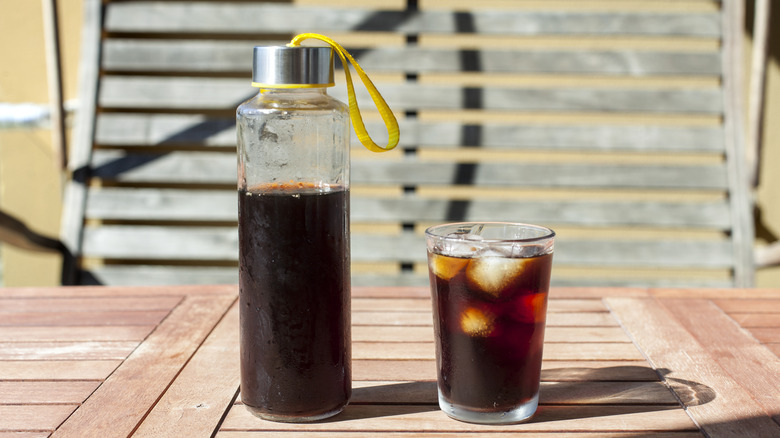What Are Rapid Cold Brew Machines And Do They Actually Work?
Ah, cold brew: iced coffee's snobby, sophisticated older sister. This buzzy, refreshing drink has taken over coffee shops across America, seemingly promising all the thirst-quenching coolness of an iced coffee without turning into the watery, diluted mess it often becomes after spending five minutes in a hot car cup holder.
Part of cold brew's appeal lies in its relative simplicity. It's crafted by soaking coarse coffee grounds in a low ratio of water for somewhere between 12 to 24 hours, creating a concentrate as potent as espresso, but without the sharp acidity. The mellow, chocolatey notes of cold brew are possible only because the beans never come into contact with heat, allowing their flavors to be slowly and carefully extracted. You can steep your cold brew for a shorter time for drink-strength coffee, or longer to create a concentrate that can be stored in a small container in your fridge and diluted as needed for a fresh cup.
The whole concept of cold brew emphasizes that it takes time, which is why it's somewhat surprising that several companies have released "rapid cold brew machines." These devices promise to brew your cold brew faster by agitating the coffee grounds, but while they might seem like an answer to your morning joe prayers, they come with a few drawbacks.
How do rapid cold brew machines work?
Rapid cold brew machine brands employ a variety of methods to craft cold brew coffee in less time. To achieve this feat, some machines rely on patented vacuum processes, other use recirculation technology, and some even leverage centripetal force. Essentially, these methods are all designed to agitate the coffee grounds without adding heat, allowing the water to become infused at a faster rate than if you were to soak coarse coffee grounds at home.
But while a rapid cold brew machine can indeed save hours compared to the traditional method, it's not exactly as "rapid" as its name might suggest. Ten minutes is often on the lower end of how long it takes to brew with one of these machines, and an extra-strength extraction can take up to 45 minutes. This duration is still about nine times longer than it takes the average drip coffee machine to do its thing.
Are rapid cold brew machines worth it?
A rapid cold brew machine might seem beneficial, if you happen to know you'll want a cold coffee in roughly one hour's time, but the results likely won't be as robust and full-bodied as a cup of traditional cold brew. The caffeine content might not be as high, and the flavors may not be as well-defined. Moreover, these machines typically brew to drink-strength rather than concentrate-strength.
When it comes to cold brew, you really can't cut corners. Having a machine loudly whirring away for 45 minutes may neither contribute to a relaxing morning, nor be kind to your electricity bill. These machines also tend to take up more space than a simple mason jar used for cold brew, can be annoying to clean, and are typically more expensive.
While they do have alternate uses, such as brewing herbal teas or infusing liquors with fresh fruit or herbs, you might find that these features don't justify the drawbacks. The truth is, you're probably better off sticking with the old-fashioned cold brew method.



